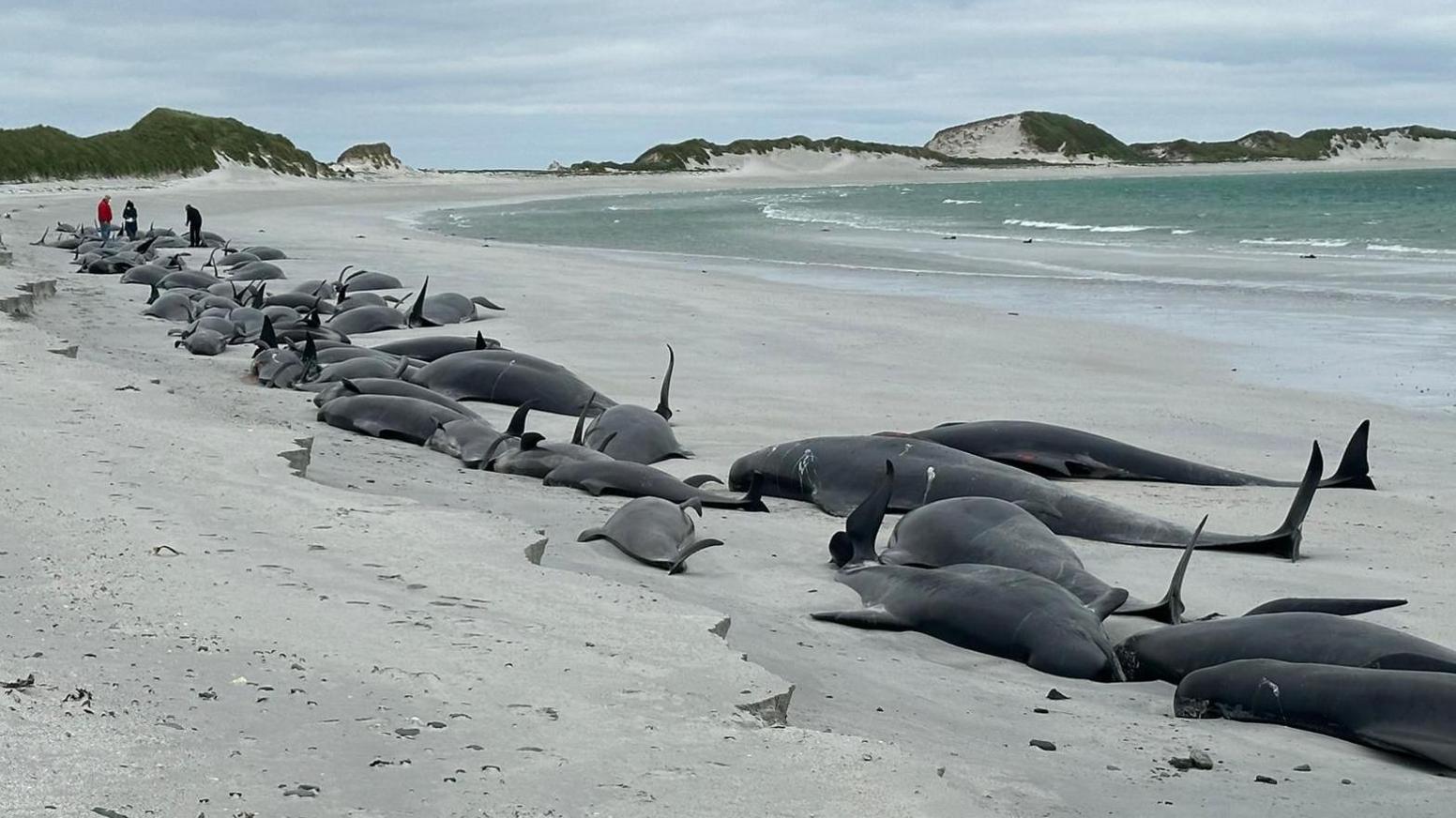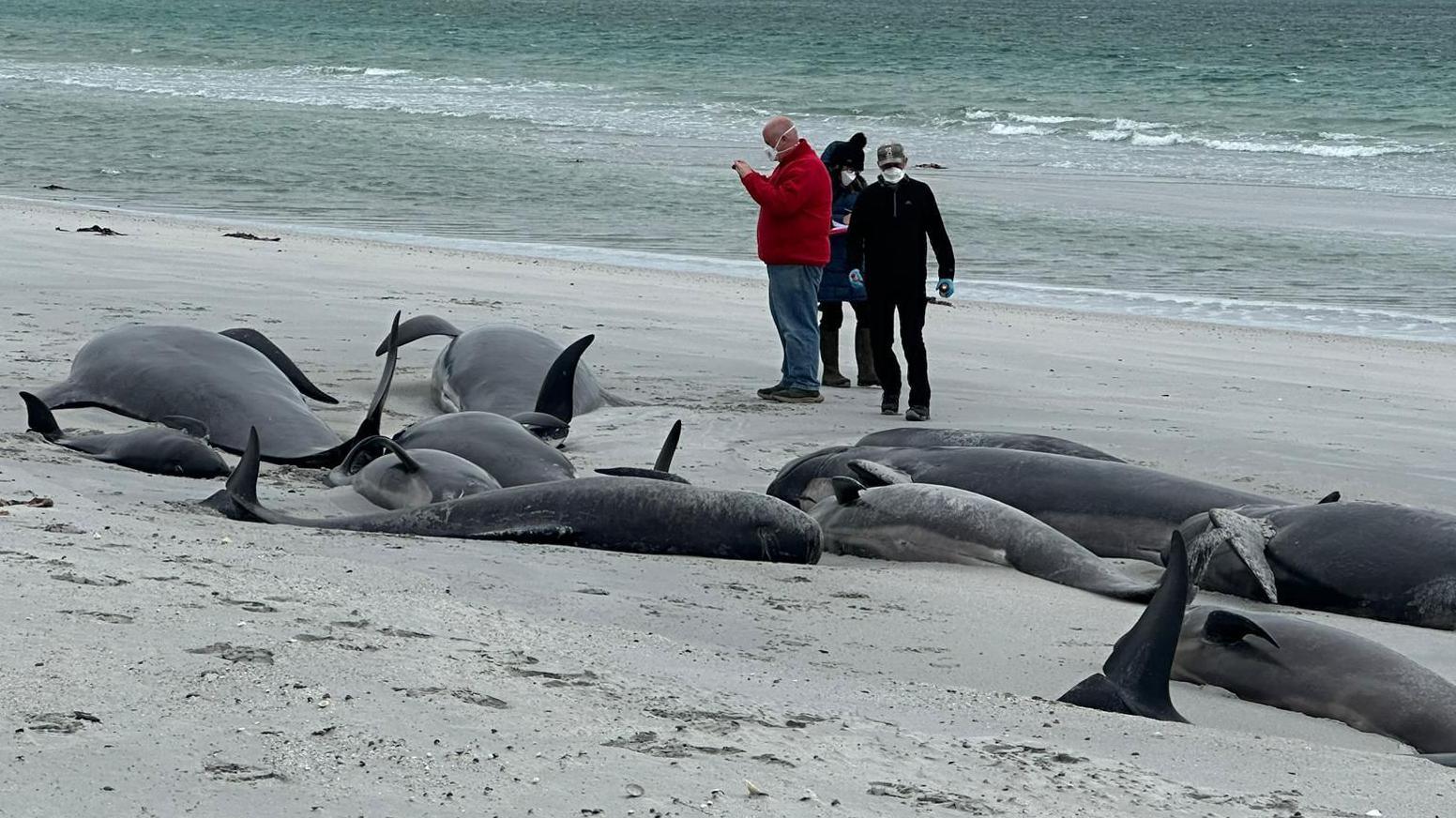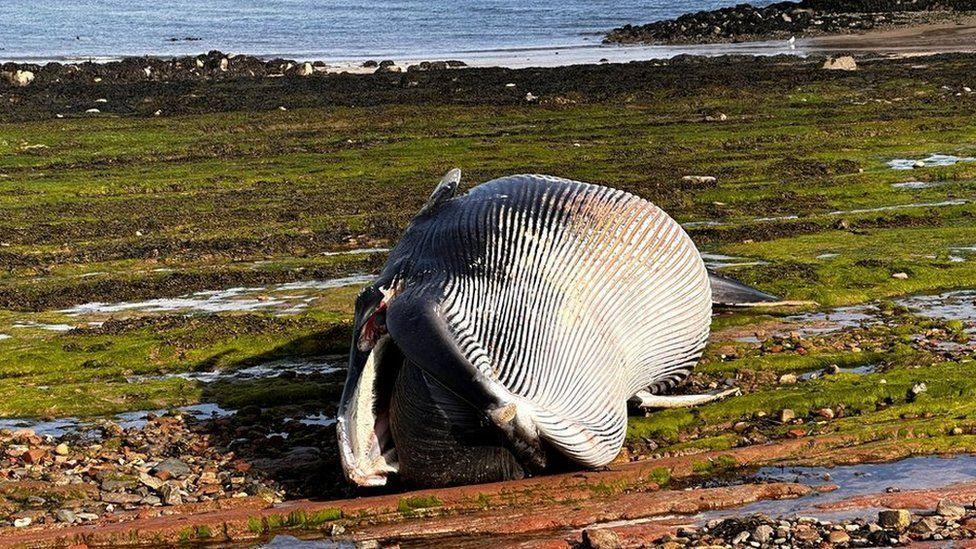How do you dispose of a whole pod of 77 whales?

- Published
The grim process of removing large animals which have died on Scotland's beaches is back in the spotlight after an entire pilot whale pod became stranded in Orkney.
Only 12 of the 77 whales were alive when they washed ashore at Tresness Beach on the island of Sanday on Thursday - they were later euthanised when efforts to refloat them failed.
It is believed to be the biggest mass stranding of whales in Scotland in decades.
Orkney Islands Council said discussions were taking place with community representatives on how best to dispose of the bodies.
If a stranded whale is found alive, an assessment to determine if it can be safely re-floated will be carried out. If not, it will be euthanised and a post-mortem examination will be carried out.
Whole pod of 77 whales likely to die in huge stranding - experts
- Published11 July 2024
Experts probe one of UK's worst whale strandings
- Published17 July 2023
These tasks will be led by the Scottish Marine Animal Stranding Scheme (SMASS).
Dr Brownlow, the director of SMASS spoke to the BBC after a giant minke whale washed up at North Berwick in East Lothian last year.
The 31ft (9m) whale died when it hit rocks and came ashore.
Dr Brownlow said that a post-mortem exam can reveal a lot about a whale's life and what influenced its death.
He detailed some of the options available to local authorities when removing a whale.
Bones in a museum

Experts from BDMLR accessed each whales washed up on Tresness Beach
Dr Brownlow said different requirements need to be balanced with making a decision about how to dispose of a carcass.
He said: "You need to remove a dead whale from a public beach so it doesn't cause distress to people, or begin to leak grease and body fluids into the environment, which are more unpleasant than they are hazardous.
"There are actually very few diseases that we've found - and we've looked very hard - which can be transmitted from dead carcasses."
Disposal options include taking the whale to a landfill site, burial on the beach or partial incineration.
"They can be taken away to our laboratories where they are post-mortemed," Dr Brownlow added.
"The skeleton is then often processed by the Museum of Scotland and added to their collection.
"The soft part goes for disposal in the same way as fallen stock do from farms."

The whales stranded on Lewis were moved to a landfill in Stornoway for post-mortem examinations
Return to the sea
In the case of the 55 whales that washed ashore on Lewis in July 2023, the animals were taken to landfill because the beach is popular with visitors and tourists.
However Dr Brownlow said that it was important to return as much of the whale as possible back into the marine environment for "nutrient recycling".
"Simply taking them out of the beach, off the marine environment and incinerating them or taking them to landfill actually robs the marine environment of this really important nutrient source," he said.
Whale carcasses can bring a dose of life-sustaining nutrients, including manganese, phosphorus, iron, zinc.
"You don't need very high levels of them but they are very important for cellular processes", Dr Brownlow added.
"It's called whale fall - this is mainly thinking about animals of the deep ocean, but when they fall and die and sink to the bottom of the ocean, they form these little nutrient rich islands that can support a huge diversity of life."
He said that sharks and other scavengers will come and eat the soft tissues of a whale, while other smaller organisms, like worms will feed on the skeleton.
Buried on the beach

A Minke whale washed up on North Berwick Beach in April 2023
Another way of returning a whale back to the environment can be through burying it on a beach.
"We can bury them on site and that's often very successful, although that has to be balanced against the backdrop of not creating a public nuisance of having a carcass on an amenity beach," he said.
Dr Brownlow added that in some circumstances, a stranded whale can be towed back into the sea, although they have to be carefully positioned to avoid becoming a shipping hazard, especially as larger whales remain buoyant.
The fate of the whale tends to depend on two factors: the size of the animal and where it has stranded.
"Some very big whales like fin whales and sei whales, if they strand on some remote island, then they can be left to break down naturally," Dr Brownlow said.
"It's amazing the speed with which scavengers, birds in particular can scavenge quite a lot from a whale and within a year or so, you're often just left with very clean bones and a very healthy marine ecosystem."
SMASS was set up to understand the causes of stranding for whales, dolphins, porpoises, seals, large bodied sharks and even marine turtles.
Dr Brownlow said he believed the minke whale stranded in North Berwick was taken to landfill for disposal.
"It's pretty grim to be honest", he said. "I've been to landfill sites to do the post-mortem and it's a pretty dismal end to such a magnificent creature,
"It's a functional end for these animals rather than one that is actually desired, both from the point of view of scientists that have to do the research on them but also the respect to the animal."